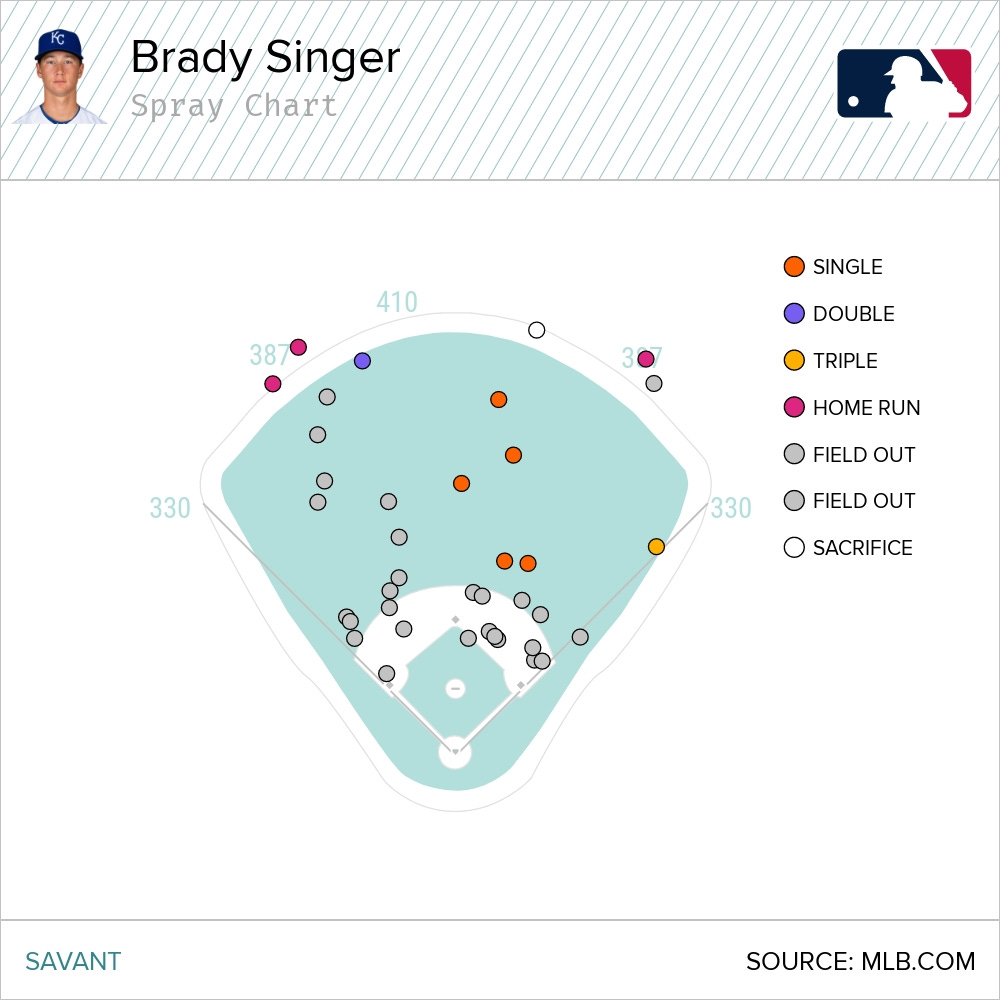One of the biggest trends in baseball over the last few seasons is the high fastball. I’m assuming since the first baseball broadcast, announcers have talked about keeping the ball down and other things that make you less smart as a baseball fan. And yet, keeping the ball up in the zone, specifically with fastballs, has proven to be a good way to get hitters out. The whole keeping the ball down thing never made that much sense to me anyway. Don’t hitters want leverage to be able to lift the ball to get it fly farther? I could go on about that for awhile, but that’s not the point here. The point is to talk about the Royals and the high fastball.
First, a brief history. The Royals under Cal Eldred’s pitching tutelage didn’t throw it much in his first two seasons as pitching coach. In 2018, they threw high fastballs 11.1 percent of the time and 10.7 percent in 2019. It had me concerned with all the young pitching working its way through the system that they wouldn’t be able to do what makes so many pitchers successful. The league averages in 2018 and 2019 were 11.6 and 12 percent respectively. That may not seem like a huge difference, but they were falling behind rapidly.
Then like a ray of sunshine on a cloudy day, 2020 happened. The year wasn’t good for much, but it did bring a year where the Royals moved forward analytically. I don’t know if that has to do with Mike Matheny’s arrival and his stated desire to be more analytical, but whatever it is, they did it, throwing high strikes 12.9 percent of the time, which was the 12th highest rate in baseball and just a stone’s throw from eighth highest really, which was the Astros at 13.1 percent. And on top of that, they were really, really good when they did it.
The Royals got the fourth highest whiff percentage on high fastballs at 17 percent, with the league average at just 14.8 percent. On at bats that ended with a high fastball, they allowed the fifth lowest batting average at .126 and tied with the Dodgers for the second lowest slugging percentage. This is all to say that they used the high fastball and they used it well.
But I think they can get better.
With two strikes, the Royals got more swings and misses by percentage than any team in baseball, and it wasn’t particularly close. Nearly one in four pitches with two strikes on high fastballs were whiffs against the Royals. League average was 18.9 percent. The .087 average allowed in those situations was again fourth best in baseball. The .111 SLG was also fourth best. And they’re in that stratosphere with the A’s, Braves and Dodgers, all excellent teams in 2020. But they weren’t throwing it enough. They threw the high fastball on 13.7 percent of two-strike pitches. That’s just league average, at 16th in baseball. For a team that performs so well in that area, why not throw it more?
Some of the Royals best pitchers - Jesse Hahn, Josh Staumont, Trevor Rosenthal, Brad Keller and Brady singer - threw the high fastball with two strikes more than league average. The highest opponent’s average from any of those five was .143. Take away the two strike parameter and 11 Royals pitchers threw more high fastballs than average. Glenn Sparkman was the only one to allow opponents to hit more than .172. Only Sparkman and Danny Duffy allowed a slugging percentage on those pitches above .111. They were actually the only two of the above average list to allow an extra base hit with a high fastball in 2020.
I’d really like to see some of the pitchers on the staff flip some pitch percentages on two strikes and go more toward the high fastball. A pitcher like Brady Singer, for example, had an excellent slider in 2020 and he did get a good chunk of whiffs on it with a 32.8 percent whiff rate in general, but it was just 22.2 percent with two strikes. Before two strikes, opponents took 34.5 percent of his sliders for a ball. That jumped to 41.8 percent with two strikes. He became far too predictable and allowed hitters to get back into counts, which caused him some problems.
That’s not to mention that he simply hung too many sliders with two strikes. Take a look at this spray chart below:
Now take a look at his spray chart on high fastballs with two strikes:
Singer isn’t the only one, but if he can actually introduce a better changeup, the high fastball could be an even bigger money maker for him in 2021 and beyond. Even if he can’t, he really ought to work that in more than he has and use his slider to set up the high heater with two strikes. He just has so much movement on that pitch that it can be a nightmare for opposing hitters.
So maybe if the Royals continue to steer into this skid and really lean into the high fastball later in counts, we can see the strikeout rates continue to increase and see what kind of wonders it does for the young pitching as it continues debut both this season and beyond.






In the past I have been frustrated that umpires do not call the high strike. Is there any evidence that has changed in recent years? This is my main argument for robot umpires. Aaron Judge's strike zone should be much different than Nicky Lopez zone.
Just to add to that thought, pretty much all other secondary offerings are far more effective low in the zone, changeups, curveballs, sliders.... nothing easier to hit than a high hanging curveball or changeup. The fastball is the only pitch you can get away with throwing high in the zone.